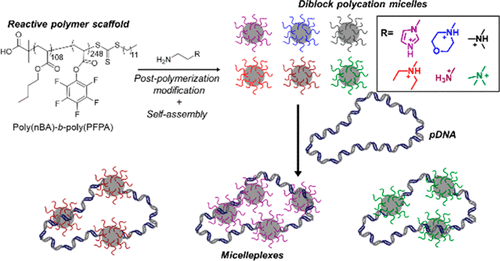当前位置:
X-MOL 学术
›
ACS Macro Lett.
›
论文详情
Our official English website, www.x-mol.net, welcomes your
feedback! (Note: you will need to create a separate account there.)
Cation Bulk and pKa Modulate Diblock Polymer Micelle Binding to pDNA
ACS Macro Letters ( IF 5.1 ) Pub Date : 2022-04-08 , DOI: 10.1021/acsmacrolett.2c00015 Cristiam F Santa Chalarca 1 , Rishad J Dalal 1 , Alejandra Chapa 2 , Mckenna G Hanson 1 , Theresa M Reineke 1
ACS Macro Letters ( IF 5.1 ) Pub Date : 2022-04-08 , DOI: 10.1021/acsmacrolett.2c00015 Cristiam F Santa Chalarca 1 , Rishad J Dalal 1 , Alejandra Chapa 2 , Mckenna G Hanson 1 , Theresa M Reineke 1
Affiliation

|
Polymer-based gene delivery relies on the binding, protection, and final release of nucleic acid cargo using polycations. Engineering polymeric vectors, by exploring novel topologies and cationic moieties, is a promising avenue to improve their performance, which hinges on the development of simple synthetic methods that allow facile preparation. In this work, we focus on cationic micelles formed from block polymers, which are examined as promising gene compaction agents and carriers. In this study, we report the synthesis and assembly of six amphiphilic poly(n-butyl acrylate)-b-poly(cationic acrylamide) diblock polymers with different types of cationic groups ((dialkyl)amine, morpholine, or imidazole) in their hydrophilic corona. The polycations were obtained through the parallel postpolymerization modification of a poly(n-butyl acrylate)-b-poly(pentafluorophenyl acrylate) reactive scaffold, which granted diblock polymers with equivalent degrees of polymerization and subsequent quantitative functionalization with cations of different pKa. Ultrasound-assisted direct dissolution of the polycations in different aqueous buffers (pH = 1–7) afforded micellar structures with low size dispersities and hydrodynamic radii below 100 nm. The formation and properties of micelle–DNA complexes (“micelleplexes”) were explored via DLS, zeta potential, and dye-exclusion assays revealing that binding is influenced by the cation type present in the micelle corona where bulkiness and pKa are the drivers of micelleplex formation. Combining parallel synthesis strategies with simple direct dissolution formulation opens opportunities to optimize and expand the range of micelle delivery vehicles available by facile tuning of the composition of the cationic micelle corona.
中文翻译:

阳离子本体和 pKa 调节二嵌段聚合物胶束与 pDNA 的结合
基于聚合物的基因递送依赖于使用聚阳离子的核酸货物的结合、保护和最终释放。通过探索新的拓扑结构和阳离子部分,工程聚合物载体是提高其性能的有希望的途径,这取决于开发易于制备的简单合成方法。在这项工作中,我们专注于由嵌段聚合物形成的阳离子胶束,它们被视为有前途的基因压实剂和载体。在这项研究中,我们报告了六种两亲性聚(丙烯酸正丁酯)-b的合成和组装。-在其亲水性冠中具有不同类型的阳离子基团((二烷基)胺、吗啉或咪唑)的聚(阳离子丙烯酰胺)二嵌段聚合物。聚阳离子是通过聚(丙烯酸正丁酯) -b-聚(丙烯酸五氟苯基酯)反应性支架的平行后聚合改性获得的,该支架赋予二嵌段聚合物具有相等的聚合度,随后用不同p K a 的阳离子进行定量功能化。. 超声辅助聚阳离子在不同水性缓冲液(pH = 1-7)中的直接溶解提供了具有低尺寸分散性和低于 100 nm 的流体动力学半径的胶束结构。胶束-DNA 复合物(“胶束复合物”)的形成和性质通过 DLS、zeta 电位和染料排除测定进行了探索,揭示了结合受到胶束冠中存在的阳离子类型的影响,其中体积和 p K a是驱动因素胶束复合体的形成。将平行合成策略与简单的直接溶解配方相结合,通过轻松调整阳离子胶束电晕的组成,为优化和扩大可用胶束递送载体的范围提供了机会。
更新日期:2022-04-08
中文翻译:

阳离子本体和 pKa 调节二嵌段聚合物胶束与 pDNA 的结合
基于聚合物的基因递送依赖于使用聚阳离子的核酸货物的结合、保护和最终释放。通过探索新的拓扑结构和阳离子部分,工程聚合物载体是提高其性能的有希望的途径,这取决于开发易于制备的简单合成方法。在这项工作中,我们专注于由嵌段聚合物形成的阳离子胶束,它们被视为有前途的基因压实剂和载体。在这项研究中,我们报告了六种两亲性聚(丙烯酸正丁酯)-b的合成和组装。-在其亲水性冠中具有不同类型的阳离子基团((二烷基)胺、吗啉或咪唑)的聚(阳离子丙烯酰胺)二嵌段聚合物。聚阳离子是通过聚(丙烯酸正丁酯) -b-聚(丙烯酸五氟苯基酯)反应性支架的平行后聚合改性获得的,该支架赋予二嵌段聚合物具有相等的聚合度,随后用不同p K a 的阳离子进行定量功能化。. 超声辅助聚阳离子在不同水性缓冲液(pH = 1-7)中的直接溶解提供了具有低尺寸分散性和低于 100 nm 的流体动力学半径的胶束结构。胶束-DNA 复合物(“胶束复合物”)的形成和性质通过 DLS、zeta 电位和染料排除测定进行了探索,揭示了结合受到胶束冠中存在的阳离子类型的影响,其中体积和 p K a是驱动因素胶束复合体的形成。将平行合成策略与简单的直接溶解配方相结合,通过轻松调整阳离子胶束电晕的组成,为优化和扩大可用胶束递送载体的范围提供了机会。











































 京公网安备 11010802027423号
京公网安备 11010802027423号